Their native habitat is tropical areas of the Far East, where they are found in stagnant peat-laden waters of thickly vegetated ditches and ponds. All are omnivores; almost all are easy to keep in an aquarium except for murderous males, which must either be kept in solitary glory or disposed of. (Males have a long and pointed dorsal fin, females shorter and rounded.) If you go away for a week they'll eat your plants - no need to worry about your Aunt Mary overfeeding them to death because 'they looked so hungry'. However, they benefit from extra meat while breeding.
They are members of the suborder Anabantoidei: labyrinth fishes. Like most other fish, they breathe with their gills, but they also possess a supplemental breathing structure, the labyrinth. This air holding structure, located in a chamber above the gills, is liberally supplied with blood vessels that supplement the gills in hot low-oxygen water. Some labyrinth fish can stay alive for a long time out of water as long as they stay moist; a few can even flop across land for short distances. For the aquarist, it means they don't need noisy aerators or circulating pumps.
At any one time I keep 5 species in breeding pairs, and a few more in tanks where they fit, all in soft, warm (25°C), slightly acidic (6.8 pH) water. Most Anabantids are very susceptible to fungi; some aquarists feel that keeping them in brackish water helps. Since their native waters have no salt, I don't.
The Genus Colisa
Members of this genus are sold under a variety of nonsense names, most with honey in the name, even those that are bright red! I find them all to be excellent community fish, but, unfortunately, short-lived compared to other Anabantids.Colisa chuna
Chuna is the Indian name for this fish. When spawning, the male becomes a brilliant ochre to red with blue to black throat and black on the front of the anal fin. Size to 5 cm. They are supposed to be able to spit waterdrops, which they use to knock insects onto the water surface where they can be eaten, but I've never seen one do it.Colisa lalia
The native species is handsome enough with its vertical red stripes, but the blue selections really put on a show. Size to 6 cm.Colisa sota
A colourful active little fish that stays out in the open and haunts the front glass whenever I'm around. Both honey yellow and red selections are available.Pearl Gourami
Trichogaster leeri. Named for its pearl-like sheen. A light horizontal black line runs from the mouth to the tail, where it ends in a small spot. Size to 12 cm, lifetime to 8 years. When in breeding condition, the males are incredibly beautiful, their breast from mouth to anal fin being a bright orange-red. The male's dorsal (back) fin is elongated and has filamentous ends. A male needs a female around to put on his best show - two is better to let them relieve each other from his attentions.Moonbeam Gourami
T. microlepis. For me, this species is an exception to the rule that males are the territorial enforcers - a female killed everything else in the tank, including the male in the photo. So, she now is restricted to an equally belligerent paradise gourami for company. When she breaks off a leaf, she treats it as if it were an enemy fish, until it is shaken to pieces, but has learned the hard way to not provoke the paradise fish.Snake-skin Gourami
T. pectoralis; a double reference to the belly, or pectoral, fins. Size to 25 cm. Very peaceful community fish despite their size, they apparently won't eat the fry of even other species. And, they have an elaborate ritual to keep them from damaging their own species. When two males approach, if one turns sideways with head slightly down, the other instantly stops its attack and swims backwards along the same route it came. When both fish agree, they lock mouths and push forward and backward to show their strength. One of my males is clearly stronger than the other, but the ritual is repeated dozens of times a day. Meanwhile, the female browses unmolested, the opposite of most gouramis. Be forewarned though, that if you have only one dominant fish (male or female), the life of other snake-skins in the tank can be miserable.Three-spot Gourami
T. trichopterus; hair wing; again referring to those pectoral fins. The third "spot" is the eye. Most are selected for blue colour, called (naturally) Blue Gouramis; opaline, marbled, silver, and gold-coloured selections are also common. All are usually marked with faint transverse stripes. Size to 12 cm., lifetime to 4 years. I recommend getting only females - they look just as good as the males and I find them far more reasonable as community fish.Croaking Gourami
Trichopsis pumila. Small, not particularly colourful, spent all their time in hiding, and I never heard even the slightest sound from them. No more.Plants
Plants are important for gouramis, for refuge when the male gets testy and as food. Here are the ones I'm growing successfully so far:Anubias barteri. Grows very slowly from a creeping rhizome.
Chinese Ivy, Cardamine lyrata. A delicate but fast-growing vine. Fine roots sprout from the bases of the leaves. A wonderful brood plant.
Amazon Sword, Echinodorus amazonicus. Slow-growing rosette plant with broad leaves. The ruffled varieties don't accept acid water, but several others do. They shed a lot more debris than most plants.
Giant Hygro, Hygrophila corymbosa. A fast-growing stem plant, it's filling a 180 l tank.
Water Wisteria, Hygrophila difformis. A thick-growing stem plant with opposite leaves. It looks messy once it puts on any height, so I'm keeping most of it trimmed as a ground cover, where it looks good and does well.
Lighting
Plants have a very different response to differing colours of light than humans do, and the lumen is a purely human measure. Here is a method of measuring Plant-Growth Lumens.Recent advances in compact fluorescent technology have greatly increased our options for the lighting of small aquaria. Not only do they start with a timer if desired, they are available in such a range of powers (5-28 W in physical sizes that fit standard aquarium hoods) that a tank can be fitted with exactly the light that looks best and is best for the plants and fish you choose. Here is how I use them:
| l | plant | W | PGL-hr/l | W/gal |
|---|---|---|---|---|
| 35 | Anubias barteri | 10 | 90 | 0.9 |
| 35 | Cardamine lyrata | 14 | 170 | 1.7 |
| 35 | Echinodorus amazonicus | 18 | 200 | 2.0 |
| 50 | Hygrophila difformis | 26 | 250 | 2.5 |
| 180 | Hygrophila corymbosa | 50 | 150 | 1.5 |
Using compact fluorescents, I can change any of the light levels as quickly as I can change a light bulb, unlike tube fluorescent fixtures. Up to 2½ times the light intensity is available as with standard tube fluorescent hoods.
Unfortunately, the aquarium industry has not yet adapted to recent technology. I can't find a single maker of a hood wider than 19" with sockets suitable for standard compact fluorescents, nor any made for more than two lamps. Not only that, but most are rated for 30 W or even less. However, All-Glass Aquarium makes one rated at 50 W, and it works well for me at that level (although it looks decidedly small on a 180 l tank!)
Ecology
When I started keeping fish in the 1940's, everyone 'knew' that a balanced aquarium had plants to oxygenate the water (but not enough to hide the fish), a bottom feeding fish to clean up the gravel, snails to eat the algae, and an aerator to oxygenate the water. Later, everyone also had to have a filter, usually powered by the aerator, so the water was perfectly transparent, unlike natural ponds where the water is alive with tiny living things.Today, we realise that all fish, bottom feeders included, are part of the ecological load on an aquarium, and so are snails and plants (especially the latter if light is inadequate). In short, keep the living things you enjoy, and skip the rest. We have found that almost all the benefit of an aerator is to keep the water moving at the surface so that oxygen and carbon dioxide can exchange effectively there; underwater pumps work just as well and are quieter. And, many are finding that most fish are healthier without intensive water filtration.
Gouramis get most of their air from the surface directly, and prefer no water current. Plants for them are for shelter and food, not oxygen. And, unless overfed, they scour the bottom for leftover food as thoroughly as any Corydora and clean up algae better than any snail. Soft water the right temperature, thickly growing plants, and food are all they need. I use natural gravel and high-protein flake food.
John Sankey
see also:
Aquarium Plant Lights
Aquarium Water Changing
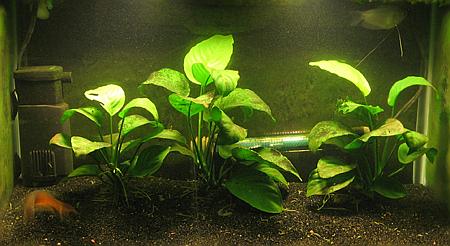
Anubias barteri
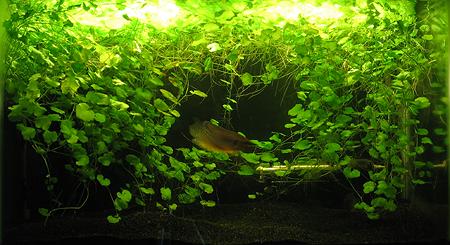
Cardamine lyrata
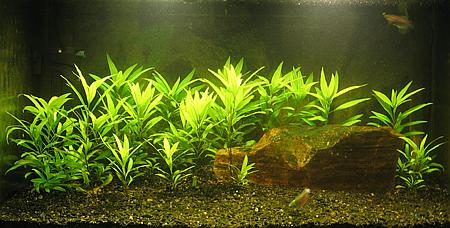
Hygrophila corymbosa
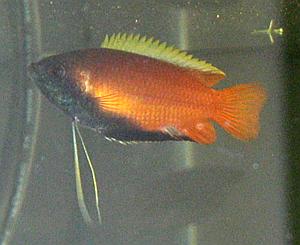
Colisa chuna
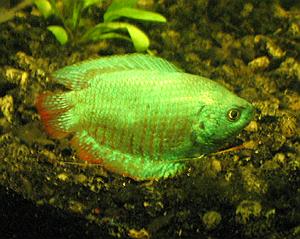
C. lalia
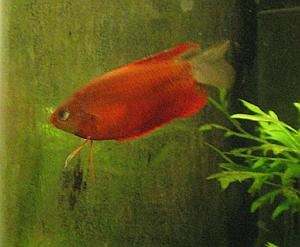
C. sota
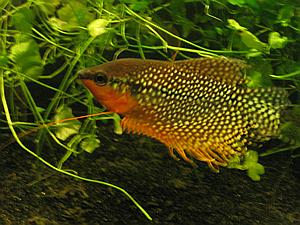
Trichogaster leeri
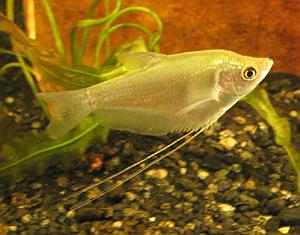
T. microlepis
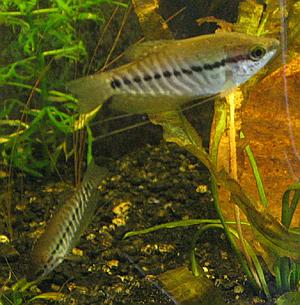
T. pectoralis
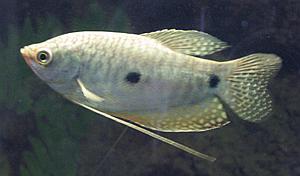
T. trichopterus
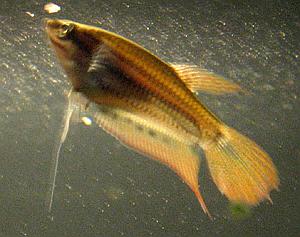
Trichopsis pumila
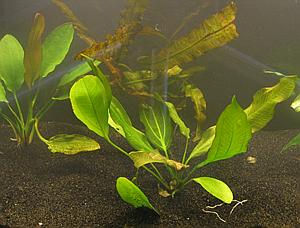
Echinodorus amazonicus
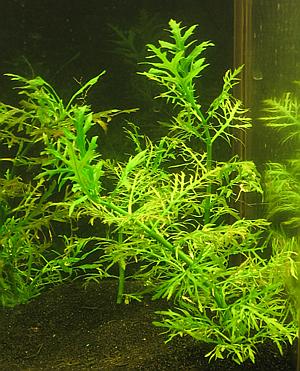
Hygrophila difformis